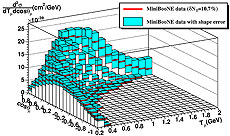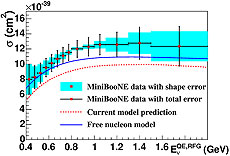MiniBooNE uses neutrinos to shed light on nuclear physics

Double differential cross section for muon neutrino CCQE scattering on carbon as recently reported by MiniBooNE. This measurement is the first of its kind for this process.

Total cross section for muon neutrino CCQE scattering on carbon as measured by the MiniBooNE experiment. The measurement is 30 percent larger than measurements predicted in current neutrino generators and may be evidence for a neglected nuclear physics process.
Most of the time, MiniBooNE studies the phenomenon of neutrino oscillations, how neutrinos change from one type into another over a distance. But recently, MiniBooNE has taken a more careful look at neutrino scattering, the way that this normally invisible particle shows itself by interacting with visible matter. Looking closer at how neutrinos interact can help physicists better understand this ghostly particle.
Measuring a cross section for neutrino interactions can be a difficult task. Neutrino cross sections are very small and measuring them requires knowing precisely how many neutrinos are hitting a detector within a given period of time. Physicists typically don't know exactly how many neutrinos are produced in an accelerator beam. This uncertainty isn't a problem for neutrino oscillation searches, because of what they are measuring. The procedures these oscillation experiments use, however, can sweep some interesting physics under the rug.
To take a closer look at neutrino scattering, MiniBooNE first worked to reduce this large neutrino production uncertainty, which is typically 30 percent or more, with the help of the HARP experiment at CERN. HARP replicated the MiniBooNE beam and measured the rate of pions produced on the MiniBooNE target, which in turn allowed scientists to predict neutrino production in the Fermilab Booster neutrino beam to within a 9 percent error margin. This allows MiniBooNE physicists to directly measure the interaction cross sections for neutrino processes.
The new result, recently reported in Physical Review D, is an absolute measurement of the double differential cross section, the number of events physicists see as a function of muon energy and angle for neutrino charged-current quasi-elastic (CCQE) scattering. This process occurs when a neutrino strikes a neutron in a carbon nucleus and creates a muon and proton.
Somewhat surprisingly, the MiniBooNE measurement is approximately 30 percent higher than predicted by state-of-the-art neutrino generators. It is also 10 percent higher than the prediction for scattering from individual nucleons. This is quite remarkable, since physicists previously thought that they could understand neutrino scattering from carbon by treating the individual protons and neutrons in the nucleus as independent particles.
The result may indicate that previously neglected processes are significant in the CCQE interaction. Theorists have recently speculated that these processes may occur because of two-nucleon correlations inside the carbon nucleus. Physicists have seen this effect in electron scattering, but the implications that this has for neutrino scattering have not been appreciated, at least,not until this new measurement.
MiniBooNE's measurement is the first reported double differential cross section for this fundamental neutrino process. The cross section is important for current and near-future neutrino oscillation searches as well as for understanding the complicated physics that binds protons and nucleons inside of a nucleus.
MiniBooNE collaborator Rex Tayloe, Indiana University, will present
this result today at 4 p.m. in One West.
--- Teppei Katori, Rex Tayloe and Geralyn Zeller
|